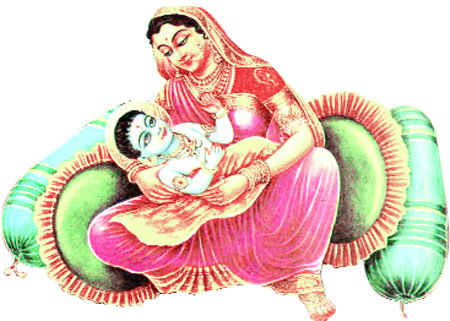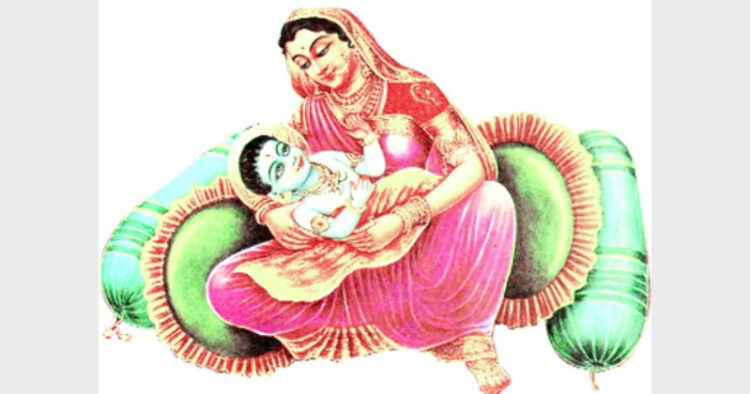 Rama is the seventh incarnation of Lord Vishnu. True to the Indian philosophy, the Paramatma or the Supreme Soul has been divided itself into three for the execution of its respective duties. Lord Brahma for creation. Lord Vishnu for sustenance and Lord Shiva for destruction.
Rama is the seventh incarnation of Lord Vishnu. True to the Indian philosophy, the Paramatma or the Supreme Soul has been divided itself into three for the execution of its respective duties. Lord Brahma for creation. Lord Vishnu for sustenance and Lord Shiva for destruction.
It is believed that whenever erosion befalls on dharma the Lord appears to destroy the evil and preserve dharma.
Ayodhya, a beautiful and self sufficient city on the bank of River Sarayu was ruled by Nemi (nick name Dasaratha), an old king in the solar dynasty. He had three wives, Kausalya, Kaikeyi and Sumitra. In spite of having three wives, king Dasaratha did not have a son and he was getting older. This worried him a lot.
One day he approached his family preceptor, saint Vasishta and revealed his mind. Saint Vasishta advised the king to conduct Puthrakaameshti sacrifice under the aegis of saint Rishyasringa.
Under Dasaratha’s orders saint Rishyasringa was invited and escorted along with other important saints and priests and a yajna was performed. At the end of the yagna, Agnideva, the God of Fire emerged from the sacrificial pyre with a golden vessel containing some divine pudding. Extending the golden vessel to Dasaratha, Agnideva said:
“O, king Dasaratha, all the gods and demigods are pleased with your sacrifice. Lo, take this pudding. Divide this among your wives consuming which they will conceive sons for you.”
Dasaratha’s joy knew no bounds. He, with utmost pleasure, divided the pudding between his three wives Kausalya, Sumitra and Kaikayi . All the queens consumed the divine offering with great joy and expectations. Eventually the three queens became pregnant.
When the pregnancy grew full and complete, Kausalya gave birth to a baby boy. The next day Kaikeyi delivered another boy and the following day Sumitra delivered the twin boys. Dasaratha was in a state of ecstasy. With songs, dances and celebrations, the whole of Ayodhya echoed her happiness.
All the four cherubs were very handsome and resplendent with their natural aura. Kausalya’s son was slightly blackish-blue in colour. At the time of birth he gave sings to mother Kausalya that he was the incarnation of Lord Vishnu himself. He bore Sankhu (conch), Chakra (disc), Gada (mace) and Padma (lotus) in his hands. He was so lustrous as if a thousand Suns raised and sparkled simultaneously at one sport. She saluted and entreated to the infant:
“O lord! Please don’t put me into hallucination. Observing you in your universal energy, my pragya (consciousness) drains away.”
The babe gave a fascinating smile, looked tenderly on the face of his mother and addressed her thus:
“The Asura dynasty has gone terribly arrogant putting the world order in disarray. The Bhumidevi (mother Earth) can no more tolerate their burden. Led by her, Lord Brahma and the Devas came to Vaikunta and entreated to me to put an end to the evil Asura forces. To accomplish both these responsibilities at a time, I have born as your son. My spouse Sri Lakshmi has taken birth as Sita, the daughter of king Janaka of Mithila. She will be the cause of root-out of the Asura clan. All devas have now taken birth as monkeys in down south to assist me. These three brothers of mine are my own insignia.”
The Lord then concluded: “This form of mine has not so far been exposed to anyone. Now, as you have requested, I am transforming into an ordinary human being.” Thus said the Lord became an ordinary infant and started crying. Kausalya, who forgot the previous scene, now became an ordinary mother.
The name giving ceremony was celebrated with a grand puja and rituals under the direction of saint Vasishtra and the court priests. Kausalya’s son who conquers the onlookers’ eyes and converts all hearts into jars of joy was named “Rama”. Rama i.e. one that pleases everyone. Kaikeyi’s son, as radiant as a full moon and who would be an able administrator was named “Bharat”. Of the two of Sumitra, the first was named “Lakshmana”, the one with all wisdom and heroic signs while the second, the annihilator of all enemies was named “Satrugna”.
There was a friendly divide among the boy heroes. Lakshmana would always move in the company of Rama and Satrugna in the camaraderie of Bharat.
The boys were initiated proper education under the tutelage of sage Vasishtra, the family preceptor of Ikshaku lineage. Their wit was sharp, their grasping capacity was superb and decision making capacity was unparallel. They grew up as ideal boys whose fame spread out to all destinations.
( To be concluded )?
-K K Shanmukhan ?














Comments